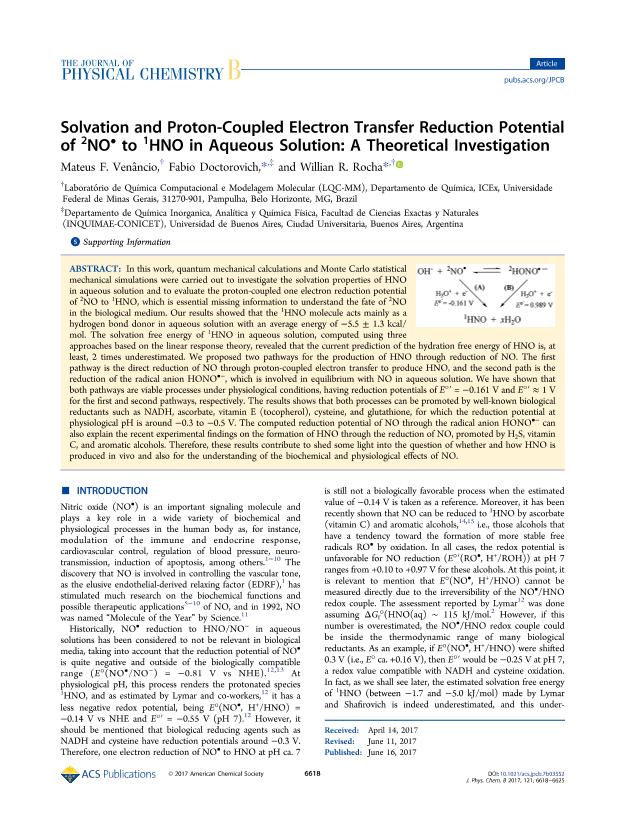Mostrar el registro sencillo del ítem
dc.contributor.author
Venâncio, Mateus F.
dc.contributor.author
Doctorovich, Fabio

dc.contributor.author
Rocha, Willian R.
dc.date.available
2018-11-27T14:45:06Z
dc.date.issued
2017-07
dc.identifier.citation
Venâncio, Mateus F.; Doctorovich, Fabio; Rocha, Willian R.; Solvation and Proton-Coupled Electron Transfer Reduction Potential of 2NO• to 1HNO in Aqueous Solution: A Theoretical Investigation; American Chemical Society; Journal of Physical Chemistry B; 121; 27; 7-2017; 6618-6625
dc.identifier.issn
1520-6106
dc.identifier.uri
http://hdl.handle.net/11336/65301
dc.description.abstract
In this work, quantum mechanical calculations and Monte Carlo statistical mechanical simulations were carried out to investigate the solvation properties of HNO in aqueous solution and to evaluate the proton-coupled one electron reduction potential of 2NO to 1HNO, which is essential missing information to understand the fate of 2NO in the biological medium. Our results showed that the 1HNO molecule acts mainly as a hydrogen bond donor in aqueous solution with an average energy of -5.5 ± 1.3 kcal/mol. The solvation free energy of 1HNO in aqueous solution, computed using three approaches based on the linear response theory, revealed that the current prediction of the hydration free energy of HNO is, at least, 2 times underestimated. We proposed two pathways for the production of HNO through reduction of NO. The first pathway is the direct reduction of NO through proton-coupled electron transfer to produce HNO, and the second path is the reduction of the radical anion HONO•-, which is involved in equilibrium with NO in aqueous solution. We have shown that both pathways are viable processes under physiological conditions, having reduction potentials of E°′ = -0.161 V and E°′ ≈ 1 V for the first and second pathways, respectively. The results shows that both processes can be promoted by well-known biological reductants such as NADH, ascorbate, vitamin E (tocopherol), cysteine, and glutathione, for which the reduction potential at physiological pH is around -0.3 to -0.5 V. The computed reduction potential of NO through the radical anion HONO•- can also explain the recent experimental findings on the formation of HNO through the reduction of NO, promoted by H2S, vitamin C, and aromatic alcohols. Therefore, these results contribute to shed some light into the question of whether and how HNO is produced in vivo and also for the understanding of the biochemical and physiological effects of NO.
dc.format
application/pdf
dc.language.iso
eng
dc.publisher
American Chemical Society

dc.rights
info:eu-repo/semantics/openAccess
dc.rights.uri
https://creativecommons.org/licenses/by-nc-sa/2.5/ar/
dc.subject
Reduction
dc.subject
Potential
dc.subject
Hno
dc.subject
Calculation
dc.subject.classification
Otras Ciencias Químicas

dc.subject.classification
Ciencias Químicas

dc.subject.classification
CIENCIAS NATURALES Y EXACTAS

dc.title
Solvation and Proton-Coupled Electron Transfer Reduction Potential of 2NO• to 1HNO in Aqueous Solution: A Theoretical Investigation
dc.type
info:eu-repo/semantics/article
dc.type
info:ar-repo/semantics/artículo
dc.type
info:eu-repo/semantics/publishedVersion
dc.date.updated
2018-10-23T18:26:15Z
dc.journal.volume
121
dc.journal.number
27
dc.journal.pagination
6618-6625
dc.journal.pais
Estados Unidos

dc.journal.ciudad
Washington
dc.description.fil
Fil: Venâncio, Mateus F.. Universidade Federal de Minas Gerais; Brasil
dc.description.fil
Fil: Doctorovich, Fabio. Consejo Nacional de Investigaciones Científicas y Técnicas. Oficina de Coordinación Administrativa Ciudad Universitaria. Instituto de Química, Física de los Materiales, Medioambiente y Energía. Universidad de Buenos Aires. Facultad de Ciencias Exactas y Naturales. Instituto de Química, Física de los Materiales, Medioambiente y Energía; Argentina. Universidad de Buenos Aires. Facultad de Ciencias Exactas y Naturales. Departamento de Química Inorgánica, Analítica y Química Física; Argentina
dc.description.fil
Fil: Rocha, Willian R.. Universidade Federal de Minas Gerais; Brasil
dc.journal.title
Journal of Physical Chemistry B

dc.relation.alternativeid
info:eu-repo/semantics/altIdentifier/doi/https://dx.doi.org/10.1021/acs.jpcb.7b03552
dc.relation.alternativeid
info:eu-repo/semantics/altIdentifier/url/https://pubs.acs.org/doi/10.1021/acs.jpcb.7b03552
Archivos asociados
